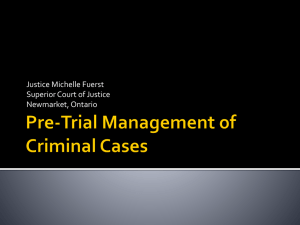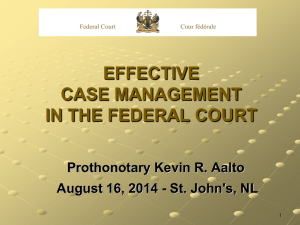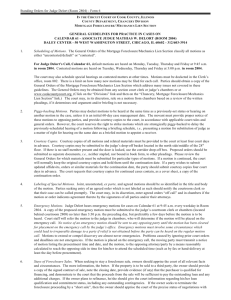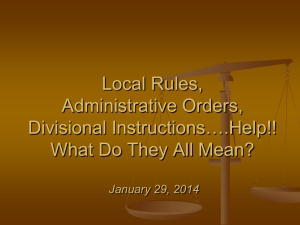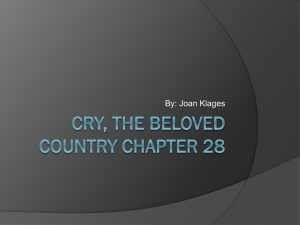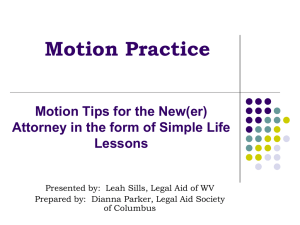Power Point Presentation - Circuit Court of Cook County
advertisement
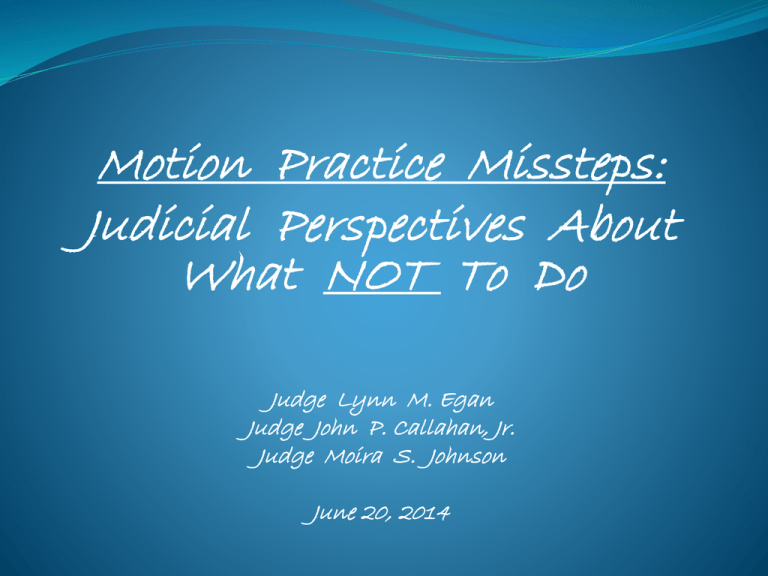
Motion Practice Missteps: Judicial Perspectives About What NOT To Do Judge Lynn M. Egan Judge John P. Callahan, Jr. Judge Moira S. Johnson June 20, 2014 MUST READ MATERIAL: “Losing Successfully on the Motion Call: Practice Hints” by Judge Willard J. Lassers. Bradshaw v. Unity Marine Corporation, Inc., 2001 WL 739951 (S.D. Tex). KNOW ALL SOURCES: Motion judges are charged with applying & enforcing a variety of statutes, rules & orders so attorneys need to know those sources: Illinois Code of Civil Procedure Illinois Supreme Court Rules Local Circuit Court Rules Local Circuit Court General Orders Law Division General Administrative Orders All can be found at www.cookcountycourt.org KNOW YOUR COURT: The organization of the Court will determine the proper forum for your motions. Familiarize yourself with the Court’s organizational structure. Learn the different “Divisions” of each “Department” & know that the Law Division is but 1 of 8 Divisions within the “County Department.” Learn the 7 different “Sections” within the Law Division. Know the difference between Motion Calls (22nd floor), Individual Calendars (General & Commercial) & Jury Rooms. KNOW YOUR AUDIENCE: Each Individual Calendar judge & most motion judges have their own Standing Order. They also use the “Motion Judges’ Rules.” These documents are the roadmap to effective advocacy before each judge. KNOW THEM & ADHERE TO THEM! Standing Orders & Motion Judges’ Rules are posted online at www.cookcountycourt.org under “Judges’ Information.” WHAT IF YOU’RE IN THE WRONG PLACE? Don’t worry – cite General Order 1.3(b): “No action shall be dismissed & no judgment…shall be vacated…because the action was filed, tried or adjudicated in the wrong department, division or district.” BUT… Get the case transferred to the proper place ASAP. (General Order 1.3(c)) WHAT IF YOU WANT TO BE SOMEWHERE ELSE? Consolidation 735 ILCS 5/2-1006 – The Why As an “aid to convenience whenever it can be done without prejudice to a substantial right.” Examples: cases similar in nature, arise from same acts, same issues or indivisible injury. General Order 12.1 – The How The Law Division Assignment Judge (Room 2005). Includes actions pending in different Departments of the Court, Divisions of the County Department & the Law Division. WHAT IF YOU WANT TO BE SOMEWHERE ELSE? Related Cases General Order 22.1 – The Why “In order to conserve judicial resources & promote efficiency…whenever it serves the convenience of interested parties & the court.” General Order 22.2 – The What Cases have at least 1 party in common, the same property, same issues of fact or law, same transaction or occurrence. General Order 22.3 – The How Law Division Assignment Judge (Room 2005) WHO SAYS YOU CAN PICK YOUR OWN JUDGE?! General Administrative Order 91-4: “Cases on the Jury & Non-Jury Trial Assignment Calls when deemed ready shall be assigned to a trial judge by random electronic process except as provided in paragraph 1.4, hereafter.” THE ORDER CONTAINS A SINGLE EXCEPTION General Administrative Order 91-4, ¶ 1.4(a): “The Presiding Judge may enter assignment orders without reference to the electronic random assignment system in cases which require intensive judicial supervision & management such as… Mass tort Commercial airplane crash Explosion Multiparty or other unusual situations which necessitate extensive pretrial activity or extended trial time. NOTE: “This exception shall be exercised on a very limited basis as the interests of justice may require.” APPEARANCES PLEASE file an appearance before addressing the Court – it is required! (Supreme Court Rule 13(c)(1) & Circuit Court Rule 1.4(a)). “Special & limited appearances” ended in Jan. 2000. “Limited scope” appearances became effective under S.Ct.Rule 13 on July 1, 2013. EXTENSIONS OF TIME Applicable Rule & Statute – Both require “good cause.” Supreme Court Rule 183 735 ILCS 5/2-1007 What if you don’t have “good cause”? JUST SAY SO!! DO NOT: Say something that isn’t accurate Blame your opponent Blame the judge ASSERTING PRIVILEGE Don’t even bother arguing your claim of privilege if you haven’t generated a privilege log. It is required under Supreme Court Rule 201(n) & must include: Description of the documents & dates generated* Things not disclosed Exact privilege being invoked If attorney-client privilege is invoked, be prepared to produce affidavit(s) establishing the factual foundation for it. PHYSICIAN DEPOSITIONS The rule that addresses non-party M.D. depositions is Supreme Court Rule 204(c). If no agreement, the requirements are issuance of a court order & payment of a “reasonable fee.” If contesting the fee, provide the judge with information about the doctor’s training, experience, board certification & hospital affiliations. RULES TO SHOW CAUSE Non-parties, not parties. Service pursuant to Supreme Court Rule 105: Summons Certified or registered mail, return receipt requested Publication (Need affidavit & court authorization) If person fails to respond, next step is a body attachment, which can only issue if there has been personal service. Supreme Court Rule 204(d). If a body attachment issues, include specific identifying information and an “I” bond amount. DISPOSITIVE MOTIONS Know the appropriate procedural vehicle for your desired relief – AND CITE IT!! (Judges don’t like to guess.) Know the limitations of the procedural vehicle you rely upon – AND DON’T EXCEED THEM! NOTICE YOUR MOTIONS FOR HEARING ASAP Circuit Court Rule 2.3: Any motion - 90 days after filing or Court may deny “by reason of delay.” Circuit Court Rule 2.1(f): Summary judgment motions must be presented for hearing at least 45 days before trial date – “unless a deadline…is otherwise specified in the case management order. CAUTION: Beware deadlines in the Standing Orders!! NUNC PRO TUNC ORDERS Nunc pro tunc is not a talisman against legal malpractice. It is only appropriate to correct clerical errors or matters of form so that the order reflects what actually occurred. It cannot be used to: Supply omitted judicial action Correct judicial errors Correct jurisdictional defects PETITIONS TO APPROVE SETTLEMENT Follow the written procedures established by the Presiding Judges of the Law Division, Probate Division & First Municipal. PLEASE !!! Failure to do so will result in delay or denial of your petition, thereby delaying payment of the settlement. PETITIONS TO APPROVE SETTLEMENT Attorney fees – Cook County Local Rules 6.4(b) & 6.5(d) for minors, disabled persons & decedents. “Fair & reasonable” or “necessary” -- Don’t ask for this language in regard to attorney fees or expenses. It is not required & doesn’t matter what the judge thinks. You get what you are entitled to under the client contract & Local Rules 6.4 & 6.5. “Detailed itemization” – Required for all expenses & don’t even bother asking for charges that amount to overhead. Probate expenses -- “Not recoverable in the Law Division.” Degrees of dependency -- MUST be agreed by all heirs, not just the Administrator. If not, there must be a hearing. TRIAL MOTIONS Don’t try to disguise dispositive motions (summary judgment or section 2-619) as motions in limine. Don’t bring oral motions in limine. (“This practice is unsupported by the case law & increases the chance of error.” Davis v. City of Chicago, 2014 IL App (1st)). Memorialize all rulings in limine in a written order that specifies the excluded evidence. Do not simply draft orders that state, “granted” or “denied.” Get the written orders signed by the Judge before opening statements. NOTE: Don’t forget to make simultaneous objections during trial. JUDGE JOHN J. CALLAHAN, JR. Motion Call “C” Room 2203 MOTION CALL PET PEEVES Long, rambling statement of facts at the beginning of a SJ motion, followed by an argument section that fails to cite to the record. Orders that merely refer to “defendant” or “plaintiff” when there are multiple defendants or plaintiffs. Forum non conveniens motions that fail to discuss the actual facts. FNC means FACTS NOT CASES. Lawyers who do not use the electronic citation format, which has been in use for nearly 3 years. Citations to the NE Reporter or Ill.Dec., rather than the new electronic format. MOTION CALL PET PEEVES Courtesy letters that fail to identify what is being submitted or when the matter is set for hearing. Motions that do not include a copy of the complaint. Reply briefs that simply cut & paste sections from opening brief. When you repeat, the Court is done reading. Deposition transcripts where the witness’ employer & job title are buried in the transcript. Provide this information to the Court in a summary of your exhibits. Emotionally charged language. Do not use adjectives & adverbs. Leave them at home for the dog to chew on. MOTION CALL PET PEEVES Sloppily written orders. Take the time to make your orders neat & legible. Sniping at opposing counsel during case management or oral argument. Attorneys who know nothing about the case, but were sent to “cover” the CMC. Off to the jury room & the end of the call. Discovery responses that refer to an entire medical chart, but to no specific page. Boilerplate discovery objections that do not explain why a request is unduly burdensome, overly broad or vague. MOTION CALL PET PEEVES Objections to discovery because a word has not been defined, but the “objectionable” word is written in plain English. Paragraphs longer than ½ page. Attempts by a settling plaintiff’s attorney to recover costs that are part of overhead, such as postage, parking, mileage & cab fare. When you nickel & dime your client, you cheapen yourself in the eyes of the Court. Affidavits based on what the affiant “believed” or “understood.” Subjective beliefs are not facts. Briefs without page numbers centered at the bottom of the page. JUDGE MOIRA S. JOHNSON Motion Call “F” Room 2201




